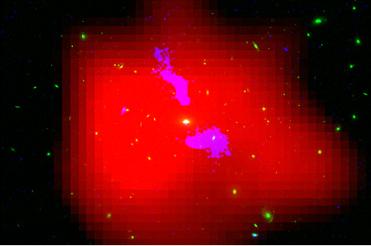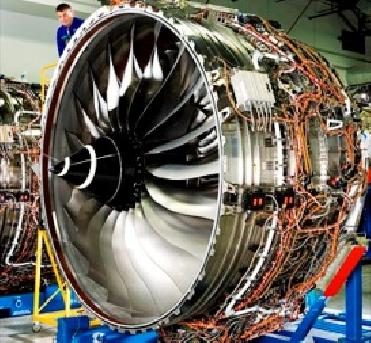
False colour image of the central region of a galaxy group in X-rays. The jet of matter blown out of the central black hole can be clearly identified by its radio luminosity (overlaid, purple-blue). Photo: S. Giodini/A. Finoguenov/MPE.
BERLIN (BNS): Astronomers have recently unraveled super-massive black holes with the mass of many millions of stars at the centre of many large galaxies.
A super-massive black hole acts like a lurking "monster" at the centre of the galaxy which swallows the surrounding material through the intensity of its gravitational pull. X-ray observations have indicated that a large amount of energy is produced by the in-fall of matter into a black hole, and ejected in powerful jets.
Astronomers from the Max Planck Institute for Extraterrestrial Physics have now shown that these jets eject matter not only from their host galaxies but even the gas between the galaxy group members, according to a news release by the Max Planck Society.
Astronomers have long been trying to understand how black holes interact with the environment (the so-called feedback), but to date the process is poorly understood. Observations and simulations have shown that active galaxies transport huge amounts of material with their jets, which are particularly luminous at radio wavelengths, into the intra-cluster gas. Signatures of this "radio-mode feedback" are observed both in radio and in X-rays.
Recent studies have shown that the amount of gas in galaxy groups, objects consisting of several galaxies bound together such as the Milky Way and the Andromeda Galaxy, does not add up to the amount predicted by cosmology - unlike in galaxy clusters with up to thousands of individual members. Large amounts of mechanical energy injected into the gas from the central black hole may have removed part of it. However to date this was only a hypothesis. Previous group samples were limited to a handful of nearby objects populated by low luminosity radio black holes.
"In galaxy groups the gas is contained by gravity. But the black holes produce so much energy that this outweighs the capacity of the group to hold its gas," explained Stefania Giodini, who is also the author of the paper published in The Astrophysical Journal.
Using one of the largest samples of X-ray detected groups and clusters of galaxies identified by XMM-Newton together with radio observations, a team of astronomers led by Stefania Giodini at the Max Planck Institute for Extraterrestrial Physics has studied the energetics of radio galaxy feedback in galaxy groups. In the COSMOS field, where almost 300 X-ray galaxy groups have been detected, the team has been able to show that the black hole activity in the centre of galaxy groups must have a dramatic effect on the surroundings: they eject sufficient energy to blow the intergalactic gas out of the gravitational well of the galaxy group. The mystery of the missing gas in galaxy groups is solved - and the large impact of black holes in galaxy groups demonstrated for the first time, as per the release.
"It is impressive what a significant influence radio outflows from galaxies can have on their surroundings," said Vernesa Smolčić from the California Institute of Technology.
 Previous Article
Previous Article Next Article
Next Article













The Indian Air Force, in its flight trials evaluation report submitted before the Defence Ministry l..
view articleAn insight into the Medium Multi-Role Combat Aircraft competition...
view articleSky enthusiasts can now spot the International Space Station (ISS) commanded by Indian-American astr..
view article